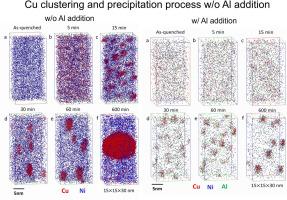铝触发富cu核壳结构的动态演化及其对纳米颗粒稳定性和硬化效应的调控
IF 14.3
1区 材料科学
Q1 MATERIALS SCIENCE, MULTIDISCIPLINARY
引用次数: 0
摘要
纳米颗粒的沉淀在决定结构材料的性能方面起着关键作用,了解其形成和稳定性的机制一直是材料科学的中心焦点。在先进铁基合金的背景下,关键问题仍然存在:是什么驱动纳米颗粒的沉淀?核壳结构是如何形成的?协同硬化的机制又是什么呢?通过将Al引入Fe-Cu-Ni合金中,我们证明了Ni和Al与Cu共簇,形成BCC Cu(Ni,Al)富簇,甚至在退火100 h后演变成热稳定的B2相。长时间退火导致Cu扩散到析出的核心中,形成一个核壳结构——一个富含Cu的核心被B2-Ni(Al)外壳包围——这与硬度降低有关。相比之下,FeCuNi合金由于Cu和Ni在Fe基体中的高扩散率而表现出快速的析出形核,但其核壳结构表现出有限的热稳定性和机械稳定性。与FeCuNi合金相比,Cu(Ni,Al)-B2相具有更强的相稳定性,具有更高的数字密度和优异的性能。重要的是,我们的研究结果揭示了析出相的形态演变与退火时间及其力学行为之间的强烈相关性,为高性能结构材料的设计提供了新的见解。本文章由计算机程序翻译,如有差异,请以英文原文为准。

Dynamic evolution of Cu-rich core-shell structures triggered by aluminum and its regulation on the stability and hardening effects of nanoparticles
Nanoparticle precipitation plays a pivotal role in determining the properties of structural materials, and understanding the mechanisms governing their formation and stability has been a central focus in materials science. In the context of advanced Fe-based alloys, key questions remain: What drives nanoparticle precipitation? How are core-shell structures formed? And what mechanisms underlie cooperative hardening? By introducing Al into Fe-Cu-Ni alloys, we demonstrate that Ni and Al co-cluster with Cu, forming BCC Cu(Ni,Al)-rich clusters that evolve into the thermally stable B2 phase, even after 100 h of annealing. Prolonged annealing leads to Cu diffusion into the precipitate core, resulting in a core-shell structure—a Cu-rich core surrounded by a B2-Ni(Al) shell—which correlates with a reduction in hardness. In contrast, FeCuNi alloys exhibit rapid precipitate nucleation due to the high diffusivity of Cu and Ni in the Fe matrix, but their core-shell structures show limited thermal and mechanical stability. The Cu(Ni,Al)-B2 precipitates, with their enhanced phase stability, achieve a higher number density and superior performance compared to FeCuNi alloys. Importantly, our findings reveal a strong correlation between the morphological evolution of precipitates with annealing time and their mechanical behavior, providing new insights into the design of high-performance structural materials.
求助全文
通过发布文献求助,成功后即可免费获取论文全文。
去求助
来源期刊

Journal of Materials Science & Technology
工程技术-材料科学:综合
CiteScore
20.00
自引率
11.00%
发文量
995
审稿时长
13 days
期刊介绍:
Journal of Materials Science & Technology strives to promote global collaboration in the field of materials science and technology. It primarily publishes original research papers, invited review articles, letters, research notes, and summaries of scientific achievements. The journal covers a wide range of materials science and technology topics, including metallic materials, inorganic nonmetallic materials, and composite materials.
 求助内容:
求助内容: 应助结果提醒方式:
应助结果提醒方式:


